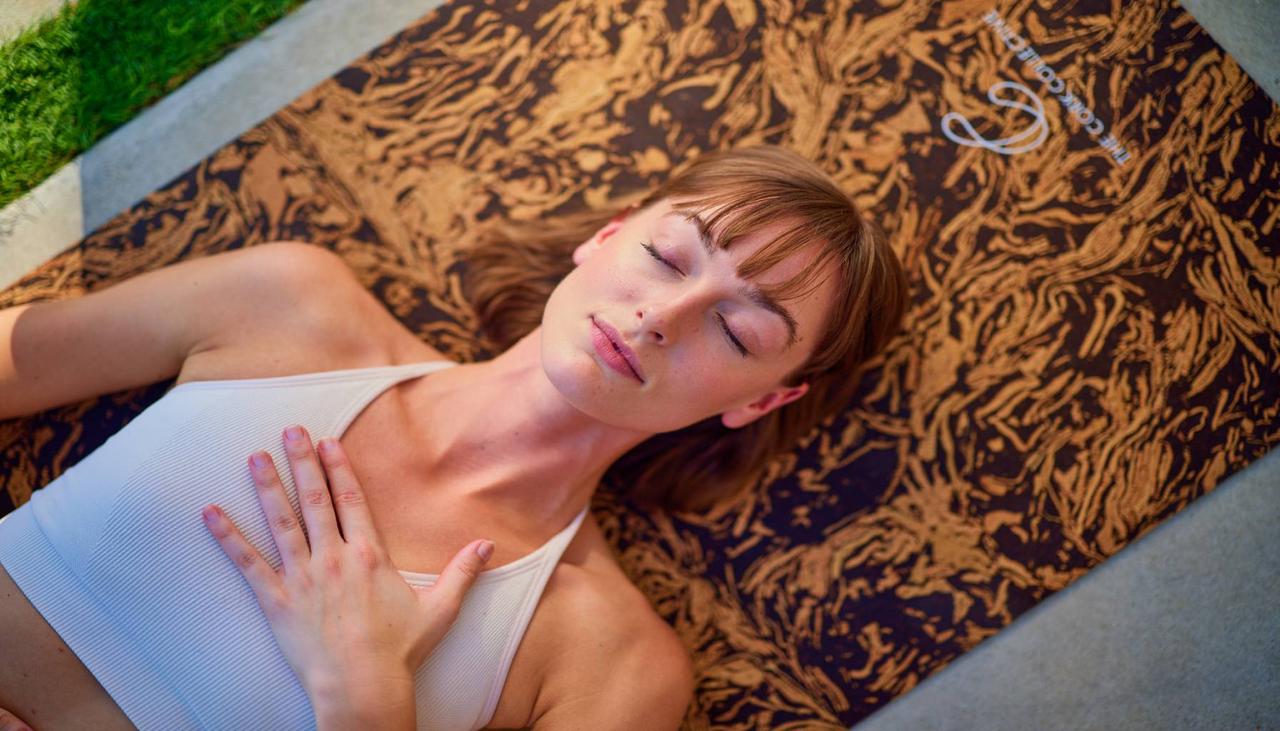Introduction
In the quest for enhancing your yoga routine, selecting the right accessories becomes crucial, and among these tools, the choice of a yoga mat can make a significant difference. A cork yoga mat, revered for its natural cushion and durability, has gained popularity as a preferred option for many practitioners. This preference is not just about the comfort and support it offers but also its contribution to well-being, eco-friendliness, and the use of renewable materials. The question of whether a cork yoga mat is better for your yoga routine hinges on various factors, including its performance, sustainability, and how it aligns with your yoga practice needs.
As we delve into the comparison, we will explore critical aspects such as determining the right thickness for optimal support and cushioning, considering where you practice to assess the mat's portability and suitability, and choosing the appropriate material that not only supports your postures but also aligns with eco-friendly and natural lifestyle choices. Evaluating the eco-friendliness of your yoga mat is essential in today's environmentally conscious world, making cork an attractive material due to its renewable properties. Through this analysis, we aim to provide a comprehensive overview of why a cork yoga mat might just be the upgrade your yoga routine needs, offering a mix of function, comfort, and responsibility towards the planet.
Determining the Right Thickness
Thick Yoga Mats
Thick yoga mats, typically around 6mm or more, offer substantial cushioning and are ideal for more therapeutic practices such as restorative yoga, where poses are held for longer periods ([10])([12])([13]). These mats are particularly beneficial for yogis with tender knees or achy joints, as they provide extra support and comfort ([10])([12])([13]). However, their thickness can sometimes make balancing during standing poses more challenging ([10])([12])([13]).
Thin Yoga Mats
Thin yoga mats, often less than 3mm, are designed for active styles of yoga that involve more dynamic and balanced poses ([10])([14]). These mats allow for better stability and a stronger connection with the floor, which is crucial during practices that require precise movements and poses ([10])([14]). Despite their lack of cushioning, thin mats are preferred for their portability and ease of use in various locations ([12])([14]).
Standard Yoga Mats
Standard yoga mats, usually about 1/8 inch (3.175mm) thick, strike a balance between comfort and stability, making them suitable for a wide range of practices ([10])([12])([14])([15]). They provide enough cushioning to protect the joints while still allowing good contact with the floor for balance and stability ([10])([12])([14])([15]). These mats are versatile and widely used due to their moderate thickness, which accommodates both dynamic and static forms of yoga ([10])([12])([14])([15]).
Considering Where You Practice
When selecting a cork yoga mat, one must consider the location of their practice, as this influences the suitability and durability of the mat. For those who practice at home, the environment is controlled, and factors like flooring may dictate the thickness and material of the mat to ensure comfort and stability ([17]). Studio practice often requires a mat that can withstand repeated use and provide sufficient grip, as studio floors can vary from wooden to carpeted surfaces ([17]). Cork mats are particularly advantageous in studios due to their durability and natural resistance to microbes, which is beneficial in shared spaces ([23]).
Outdoor practice introduces different challenges such as uneven terrain and exposure to elements. Cork yoga mats are ideal for outdoor settings due to their easy-to-clean surface and ability to repel dirt and sand, making them excellent for beach or park settings ([18]). Additionally, their natural traction enhances grip, crucial for maintaining poses on uneven ground ([19]). Whether practicing in the serenity of a home, the structured environment of a studio, or the unpredictability of the outdoors, a cork yoga mat offers the versatility and eco-friendly qualities essential for modern yogis ([17])([18])([19]).
Choosing the Appropriate Material
Cork Mats
Cork mats stand out for their sustainability and natural properties. Cork is not only renewable and biodegradable but also offers a naturally antimicrobial surface, making it ideal for maintaining cleanliness during yoga practices ([26]). These mats become grippier with sweat, providing excellent traction during intensive sessions ([30]). Cork's durability and ease of maintenance make it an excellent material for yoga mats, aligning with eco-friendly values ([26]) ([30]).
PVC Mats
PVC, or Polyvinyl Chloride, is a prevalent choice for yoga mats due to its durability and ease of cleaning. However, it's important to note that some PVC mats may contain harmful chemicals like phthalates and lead ([25]). While they are budget-friendly and offer a decent grip, their environmental impact is considerable, as PVC is non-biodegradable and emits a chemical smell ([25]) ([31]).
Natural Rubber Mats
Natural rubber mats are celebrated for their cushioning and support, making them ideal for those who need extra joint protection ([25]). These mats are derived from the rubber tree and are both biodegradable and free of the harsh chemicals found in synthetic options. However, they can be heavy and provide less comfort for sensitive knees ([25]) ([26]).
Other Material Options
Other eco-friendly materials include jute and organic cotton, which are good alternatives for those seeking sustainable yoga practice accessories. These materials are generally thicker and provide a tactile surface that enhances grip ([31]). However, they may not offer the same longevity and ease of cleaning as synthetic mats ([31]).
Evaluating Eco-Friendliness
Eco-Friendly Materials
Cork stands out as a superior choice for yoga mats due to its natural origin and minimal environmental impact. Unlike synthetic materials, cork is harvested from the bark of the cork oak tree, which regenerates over time, making it a renewable resource ([35]). Additionally, cork's natural resilience and cushioning provide a stable yet yielding surface for yoga practitioners, enhancing the overall experience without compromising the planet's health ([35]).
Recycling and Sustainability
Cork's biodegradability makes it a standout choice for eco-conscious consumers. When a cork yoga mat reaches the end of its life, it can decompose naturally, adding to the soil without leaving harmful residues. This natural breakdown process significantly reduces the waste footprint compared to synthetic materials that linger in landfills for centuries ([35]). Recycling cork is another avenue that enhances its eco-friendly credentials, as cork can be repurposed into a variety of products, showcasing its versatility ([35]).
Health Implications
The use of PVC in yoga mats is concerning due to its potential health risks. PVC may contain traces of the endocrine-disrupting chemical Bisphenol-A (BPA), which has been linked to significant changes in insulin response levels and a positive association with coronary heart disease ([36]). Moreover, toxic metals used as stabilizers in PVC, such as lead and cadmium, pose additional health risks ([36]). In contrast, natural materials like cork offer a safer alternative, being free from such harmful substances and providing a healthier practice environment ([36]).
Conclusion
Through rigorous comparison and thoughtful analysis, it becomes evident that the choice of a yoga mat profoundly impacts one’s practice, comfort, and even the environment. Cork yoga mats, with their remarkable blend of durability, cushioning, and eco-friendliness, offer a compelling alternative to traditional materials. Not only do they support a wide range of yoga practices with their optimal thickness and natural grip, but they also align with a sustainable and health-conscious lifestyle. Emphasizing the importance of material selection, cork stands out for its renewable nature and its contribution to a cleaner, greener planet, making it an ideal choice for the modern yogi.
As we reflect on the benefits and considerations discussed, the choice of a cork yoga mat represents a step toward more responsible consumption and a deeper connection with one’s yoga practice. Embrace the change towards a mindful practice and a healthier environment by considering a switch to a cork yoga mat. And for those ready to make the transition, use the Promo Code "BestCorkYogaMat" to get 15% off. By choosing cork, not only do practitioners enhance their own experience, but they also contribute positively to the well-being of our planet, embodying the true essence of yoga’s harmony with nature.
FAQs
-
What are the benefits of using a cork yoga mat?
Cork yoga mats are beneficial because they are naturally antimicrobial, thanks to compounds called Phenolics which kill bacteria and fungi. This property helps the mat stay clean and free from the odors typically associated with perspiration. Unlike synthetic mats that can absorb and retain unpleasant smells, cork mats naturally repel odors and emit a subtle, woody scent. -
What type of yoga mat is most suitable for different levels of practitioners?
For beginners, PVC mats are an affordable and grippy option. Those who prioritize environmental sustainability might prefer mats made from natural rubber or TPE (Thermoplastic Elastomer), which are also durable and non-toxic. Advanced yoga practitioners and professionals often choose high-density TPE or natural rubber mats for their resilience and performance qualities. -
Which yoga mats are preferred by yoga instructors?
Many yoga instructors favor Lululemon mats due to their smooth surface that facilitates easy movement transitions while providing adequate grip. Another popular choice is Zenlife yoga mats, which are eco-friendly, machine-washable, and excellent at absorbing sweat while being free from toxins and odors. -
How durable are cork yoga mats compared to other types?
Cork yoga mats are quite durable, typically lasting between 1 to 2 years with regular use. This lifespan is notably longer compared to mats made solely from materials like PVC, TPE, or rubber, which generally last about 8 months to a year under similar conditions.
References
[1] - https://ireadlabelsforyou.com/why-you-should-choose-this-cork-yoga-mat/ [2] - https://reviewed.usatoday.com/health/features/cork-yoga-mat-review-gaiam [3] - https://www.sunshineyoga.com/blog/why-you-need-a-cork-yoga-mat/ [4] - https://noveme.co.uk/blogs/stories/cork-yoga-mat [5] - https://yuneyoga.com/blogs/yoga-blog/choosing-the-right-cork-yoga-mat-for-your-practice [6] - https://sugitreestudio.com/blogs/from-the-blog/why-choose-a-cork-yoga-mat [7] - https://www.diyogi.com/blogs/diyogi-yoga-mat-articles-info/the-best-yoga-mat-thickness [8] - https://bodybyyoga.training/mats/ [9] - https://www.amazon.com/Luxury-Cork-Yoga-Mat-Built/dp/B07MQG5LVF [10] - https://www.rei.com/learn/expert-advice/yoga-gear.html [11] - https://www.diyogi.com/blogs/diyogi-yoga-mat-articles-info/the-best-yoga-mat-thickness [12] - https://yuneyoga.com/blogs/yoga-blog/choosing-the-right-thickness-for-your-yoga-mat [13] - https://bodybyyoga.training/lifestyle/best-thickness-for-a-yoga-mat/ [14] - https://www.rei.com/learn/expert-advice/yoga-gear.html [15] - https://www.gaiam.com/blogs/discover/how-to-choose-the-right-yoga-mat [16] - https://ireadlabelsforyou.com/why-you-should-choose-this-cork-yoga-mat/ [17] - https://www.wanderingjustin.com/best-cork-yoga-mat/ [18] - https://reviewed.usatoday.com/health/features/cork-yoga-mat-review-gaiam [19] - https://www.yogastudiostore.com/collections/outdoor-yoga-mats [20] - https://www.outdoorgearlab.com/topics/fitness/best-yoga-mat [21] - https://www.reddit.com/r/yoga/comments/67on4p/best_outdoor_yoga_mat_for_grassy_areas/ [22] - https://zenfulyoga.ca/blogs/news/sustainability-of-cork-mats [23] - https://yuneyoga.com/blogs/yoga-blog/choosing-the-right-cork-yoga-mat-for-your-practice [24] - https://www.thecultureist.com/2023/06/15/why-cork-yoga-mat-is-the-most-sustainable-and-eco-friendly-choice/ [25] - https://corkcollective.com/blogs/news/cork-vs-rubber-vs-pvc-yoga-mats-which-one-suits-you-best [26] - https://www.zonebylydia.com/blogs/inthezone/choosing-the-right-yoga-mat [27] - https://www.wavar.com/blog/eco-friendly-yoga-mat-cork-vs-tpe-vs-pvc.html [28] - https://noveme.co.uk/blogs/stories/cork-yoga-mat [29] - https://corkhouse.com/blogs/blog/5-spectacular-benefits-of-cork-yoga-mats [30] - https://corcyoga.com/2023/02/21/benefits-of-a-cork-yoga-mat-over-a-traditional-yoga-mat/ [31] - https://www.gaiam.com/blogs/discover/how-to-choose-the-right-yoga-mat [32] - https://www.rei.com/learn/expert-advice/yoga-gear.html [33] - https://www.yogastudiostore.com/pages/yoga-mat-buyers-guide [34] - https://www.doyogawithme.com/yoga-mats [35] - https://yuneyoga.com/blogs/yoga-blog/eco-friendly-choices-why-a-cork-yoga-mat-is-your-next-best-pick [36] - https://umbelorganics.com/non-toxic-yoga-mats/ [37] - https://www.goingzerowaste.com/blog/non-toxic-sustainable-yoga-mats/ [38] - https://www.doyogawithme.com/yoga-mats [39] - https://www.ecofriendlycircle.com/post/non-toxic-and-sustainable-yoga-mat-options-that-are-responsibly-made-plus-how-to-recycle-them [40] - https://ireadlabelsforyou.com/non-toxic-yoga-mat-guide/ [41] - https://scienceline.org/2020/10/why-my-yoga-mat-scared-me-and-what-i-did-about-it/ [42] - https://www.leafscore.com/blog/chemicals-in-yoga-mats/ [43] - https://noveme.co.uk/blogs/stories/cork-yoga-mat [44] - https://the-asanas.com/en-us/blogs/yoga-mindfulness/whybuycorkyogamat [45] - https://reviewed.usatoday.com/health/features/cork-yoga-mat-review-gaiam [46] - https://ireadlabelsforyou.com/why-you-should-choose-this-cork-yoga-mat/ [47] - https://corkhouse.com/blogs/blog/5-spectacular-benefits-of-cork-yoga-mats [48] - https://noveme.co.uk/blogs/stories/cork-yoga-mat





Leave a comment
This site is protected by hCaptcha and the hCaptcha Privacy Policy and Terms of Service apply.